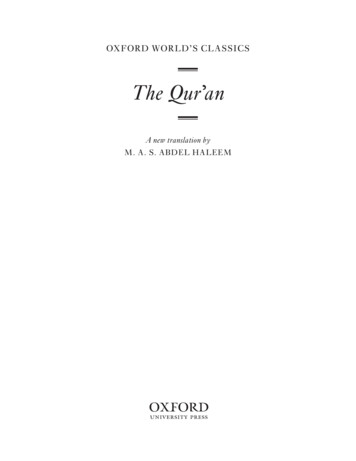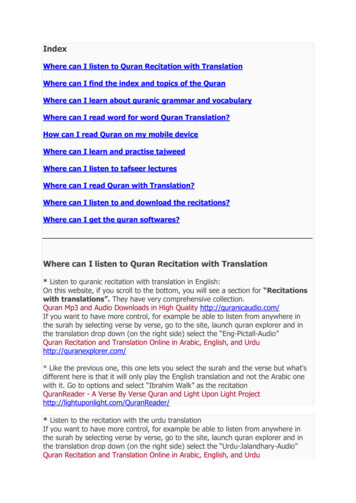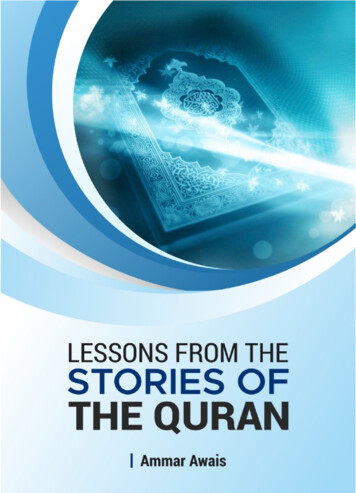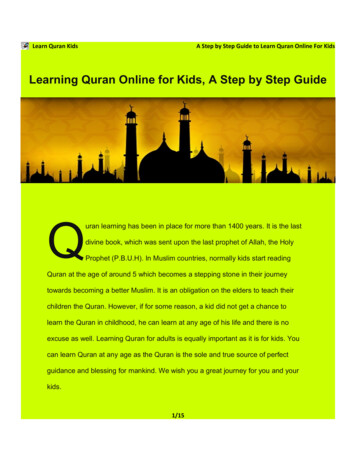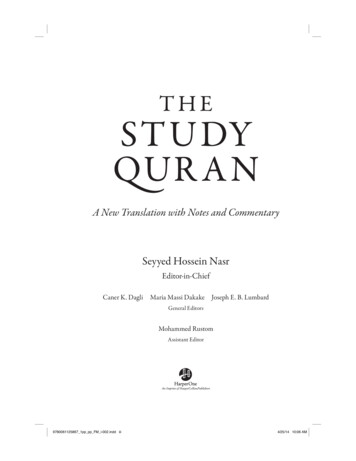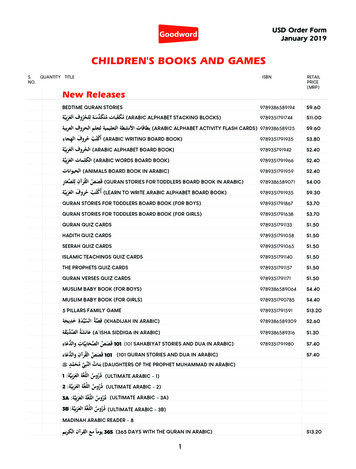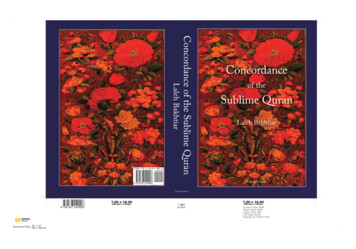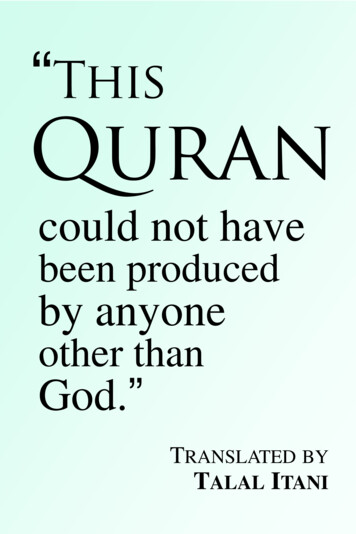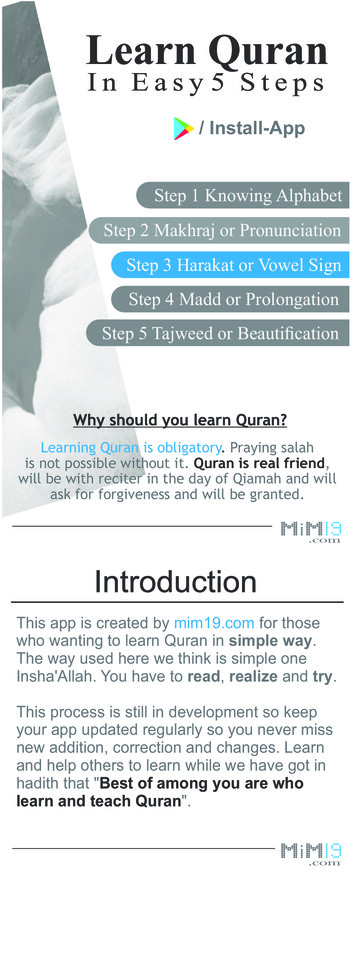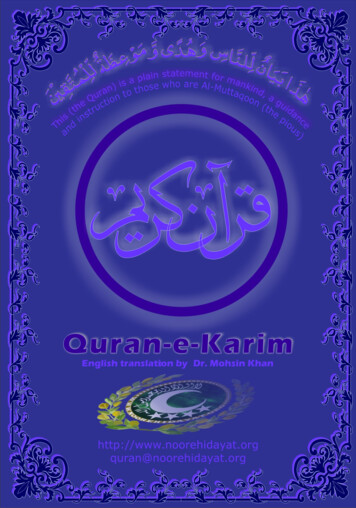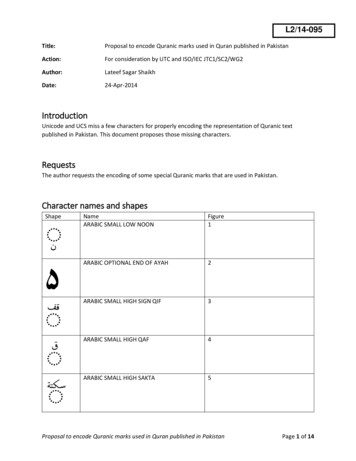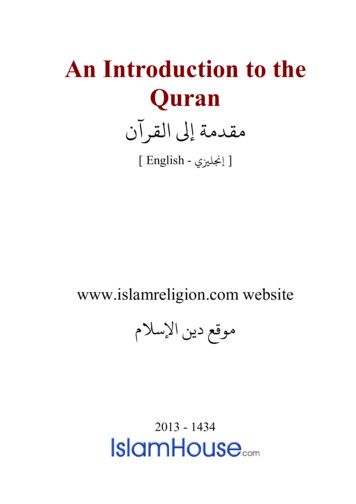
Transcription
An Introduction to theQuran ﻘﺪﻣﺔ إﻰﻟ اﻟﻘﺮآن [ English - ] إ ﻠ ي www.islamreligion.com website مﻮﻗﻊ دﻳﻦ اﻹﺳﻼم 2013 - 1434
The Quran is the Muslim scripture, that is to say the scriptureof the followers of Islam. Islam is the religion established amongthe Arabs - a people until then largely confined to the ArabianPeninsula - by the Prophet Muhammad in the early seventhcentury. The Quran was revealed to Prophet Muhammad by Godthrough the agency of the angel Gabriel; this took place partly inMecca, his hometown, and partly in Medina, where he succeededin creating a state in an otherwise stateless tribal society. Themessage was revealed in Arabic, the language of the people it wasinitially addressed to, even though the message was ultimately forthe whole of humanity. The Quran specifically mentions thatMuhammad was the messenger to the whole of mankind, and thathe is the last messenger to be sent. Thus, the Quran is the finalmessage that supersedes and reiterates the basic religion Godordained for the Jews and the Christians, as well as the Muslims.Today, the total number of Muslims in the world is over a billion,making up almost a fifth of the world’s population. For all2
Muslim communities, whatever their language and wherever theylive, the Quran is their scripture.The BasicsThe first thing to understand about the Quran is its form. TheArabic word, ‘Quran,’ literally means both ‘recitation’ and‘reading’. Similarly, the Quran was both recited orally and writtendown in book form. The true power of the Quran remains in theoral recitation, as it is meant to be read aloud and melodiously, butstill the verses were written down on available materials as an aidto memorizing and guarding it, and these were collected andordered in book form both privately and, at a later stage,institutionally. The Quran was not meant to tell a chronologicalstory, and thus, the Quran should not be viewed as a sequentialnarrative like the book of Genesis. The Arabic book that goes bythe name Quran is about as long as the New Testament. In mosteditions it is about 600 pages in length.In contrast to the Hebrew Bible and the New Testament, theQuran issued from the mouth of a single person, who recited whathe heard from the angel Gabriel. On the other hand, both theJewish and the Christian scriptures are collections of many booksthat were written down by a large number of human beings, andopinions differ as to their status as revelation.How Is The Quran Organized?The Quran is composed of 114 parts or chapters of unequallength. Each chapter is called a surah in Arabic and each sentenceor phrase of the Quran is called an aaya, literally ‘a sign.’ Like theBible, the Quran is divided into discrete units, referred to as versesin English. These verses are not standard in length or meter, andwhere each begins and ends was not decided by human beings, butdictated by God. Each one is a discrete act of locution of closedsignification, or ‘sign’, denoted by the word aayah in Arabic. Theshortest of the surahs has ten words, and the longest surah, which3
is placed second in the text, has 6,100 words. The first surah, theFatihah (“The Opening”), is relatively short (twenty-five words).From the second surah onward, the surahs gradually decrease inlength, although this is not a hard and fast rule. The last sixtysurahs take up about as much space as the second. Some of thelonger aayahs are much longer than the shortest surahs. Allsurahs, except one, begin with Bimillah hir-Rahman nir-Rahim,‘In the Name of God, the Most-Merciful, the Compassionate.’Each surah has a name that usually mentions a key motto withinit. For example, the longest surah, Surah al-Baqara, or “TheCow”, is named after the story of Moses commanding the Jews tooffer a sacrifice of a cow, which begins by God saying:“And remember when Moses said to his people: ‘Godcommands that you sacrifice a cow ’” (Quran 2:67)Since the various chapters are of various lengths, the Quranwas divided by scholars of the first century after the death of theProphet into thirty roughly equal parts, each part is called a juz’ inArabic. This division of the Quran was done in order for people tomemorize or read it in a more organized fashion, and it has noinfluence on the original structure, as they are mere marks on thesides of the pages denoting the part. In the Muslim month offasting, Ramadan, one juz’ is usually recited every night, and theentire Quran is completed in the thirty days of the month.Translations of QuranA beginner should know a few points about Quran translations.First, there is a distinction between the Quran and itstranslation. In Christian view, the Bible is the Bible, no matterwhat language it may be in. But a translation of the Quran is notthe word of God, for the Quran is the exact Arabic words spokenby God, revealed to Prophet Muhammad by Gabriel. The word ofGod is only the Arabic Quran as God says:“Indeed, I revealed it as an Arabic Quran.” (Quran 12:2)4
A translation is simply an explanation of the meanings of theQuran. That is why one modern English translation has been titled“The Meaning of the Glorious Quran”: it strives only to give themeaning, but falls short, as any translation must, of reproducingthe form of the Holy Book. The translated text loses the inimitablequality of the original, so be aware of the degree to which atranslation reflects the original message at every level of meaning,and that it will probably not match it. For this reason, all which isregarded as ‘recitation’ of the Quran is to be done in Arabic, suchas the recitation of the Quran in the five daily prayers of theMuslims,Second, there is no perfect translation of the Quran, and, beinghuman works, each almost always has errors. Some translationsare better in their linguistic quality, while others are noted for theirexactness in portraying the meaning. Many inaccurate, andsometimes misleading, translations that are generally not acceptedas reliable renditions of the Quran by mainstream Muslims aresold in the market.Third, while a review of all the English translations is out ofthe scope of this article, some translations are recommended overothers. The most widely read English translation is by AbdullahYusuf ‘Ali, followed by that of Muhammad Marmaduke Pickthall,the first translation by an English Muslim. Yusuf ‘Ali’s translationis generally acceptable, but his footnote commentary, useful attimes, can be odd and unacceptable. Another widespreadtranslation is done by Dr. Hilali and Muhsin Khan called‘Interpretation of the Meaning of The Noble Quran.’ Although itis the most accurate, the many transliterated Arabic terms andendless parentheses makes it hard to follow and confusing for abeginner. A newer version with more flowing text has beenpublished by Saheeh International, and this is probably a bettertranslation, as it combines both exactness in translation andreadability.5
Exegesis (Tafseer in Arabic)Although the meanings of the Quran are easy and clear tounderstand, one must be careful to make assertions about thereligion without relying on an authentic commentary. Not only didProphet Muhammad bring the Quran, he also explained it to hiscompanions, and these sayings have been collected and preservedtill this day. God says:“And We have sent down to you (O Muhammad) the messagethat you may explain clearly to men what is sent for them ”(Quran 16:44)In order to understand some of the deeper meanings of theQuran, one should rely upon commentaries which mention thesestatements of the Prophet as well as his companions, and not uponwhat they understand from the text, as their understanding of it islimited to their prior knowledge.A specific methodology exists for exegesis of the Quran inorder to extract the proper meaning. The Quranic sciences, as theyare called, are an extremely specialized field of Islamic scholarshipwhich requires mastery in multiple disciplines, like exegesis,recitations, script, inimitability, circumstances behind revelation,abrogation, Quranic grammar, unusual terms, religious rulings, andArabic language and literature. According to scholars of Quranicexegesis, the proper method of explaining the verses of Quran are:(i) Tafseer of the Quran by Quran.(ii) Tafseer of the Quran by the Sunna of the Prophet.(iii) Tafseer of the Quran by the Companions.(iv) Tafseer of the Quran by Arabic language.(v) Tafseer of the Quran by ‘opinion’, if it does not contradictthe above four sources.6
Muslims are absolutely convinced of the greatness andimportance of the Quran, which is usually mentioned with epithetslike “noble,” “glorious,” and “pure.” What is it that so deeplymoves the Muslim when reciting from the Quran, when seeing itsverses, or when barely touching it?The style of the Quran is inimitable and of divine beauty andpower. Try as he may, no man can write a paragraph that iscomparable to a verse of the revealed Book. This has to do partlywith the literary merit of the text and the efficacy of the words their transforming and saving power - that is inimitable. It movesan illiterate shepherd to tears when recited to him, and it hasshaped the lives of millions of simple people over the course ofalmost fourteen centuries; it has nourished some of the mostpowerful intellects known to human records; it has stoppedsophisticates in their tracks and made pious believers of them, andit has been the source of the most subtle philosophy and of an artwhich expresses its deepest meaning in visual terms; it has broughtthe wandering tribes of humanity together in communities andcivilizations upon which its imprint is apparent even to the mostcasual observer.To recite the Quran is the most sublime and edifyingoccupation for the Muslim, even when he or she does notintellectually understand its words, as is the case with most nonArab believers. The Muslims’ desire to recite the Quran asbeautifully as possible, and the art of tilāwat, the proper recitation,has developed into a science. Even when reciting the Bookwithout embellishment, one has to observe certain rules ofrecitation. The hafiz, who “preserves” the Quran, i.e., knows it byheart, is highly respected, and boys and girls are sent at an earlyage to the mosque to memorize the ‘Book.’In order not to besmirch the sacred character of the Quran, careshould be taken that it is not left in a place where someone mayaccidentally stand, sit on or otherwise disrespect it; it is extremelydisliked to use any book, let alone the Quran, as a prop for holding7
anything up. When not being read, the Muslim will replace it inthe shelf of the bookcase, or on the lectern. Some people wrap itcarefully in cloth in order to preserve it and also to be able handleit when not in a state of purity if needed. They also like to ensurethat it is placed above other books, and they avoid just letting theQuran lie around. It is absolutely forbidden to take it into the placeone urinates or defecates or that is a place of major impurity(toilets, middens, sheepcotes, city sewers, etc.). Even reciting it insuch places is a thing not done.Language of the QuranThe Quranic world view is closely tied to the Arabic language,which, like Hebrew and Aramaic (the language spoken by Jesus),belongs to the Semitic family. The Quran defines itselfspecifically as an ‘Arabic scripture’, and the message is shaped tothe complex structure of the chosen language, a structurefundamentally different to that of any European tongue. Theinternal logic of Semitic languages is very different from that ofIndo-European languages such as English, Latin, Sanskrit, andPersian. Every Arabic word may be traced back to a verbal rootconsisting of three, four or five consonants from which are derivedup to twelve different verbal modes, together with a number ofnouns and adjectives. This is referred to as the triliteral root, andspecific words are formed from it by the insertion of long or shortvowels and by the addition of suffixes and prefixes. The root assuch is ‘dead’ - unpronounceable - until brought to life, that is tosay vocalized, by the vowels, and it is according to their placingthat the basic meaning is developed in a number of differentdirections. The root has sometimes been described as the ‘body’while the vowelling is the ‘soul’; or again, it is from the root that agreat tree grows. Without understanding the meanings and therelated concepts of the Arabic words, it is impossible to appreciatethe richness of the associated meanings, the difficulty oftranslating words into English, and the interrelationships amongArabic words that are obvious in the original.8
The Muslims’ preoccupation with the sublime language of theQuran grew into the study of grammar and rhetoric, especiallywhen non-Arabs entered the fold of Islam in increasing numbersand had to be taught about the peculiarities of the language ofrevelation. The belief that the Book was untranslatable forcedthose who embraced Islam to learn Arabic or at least to becomeacquainted with the Arabic alphabet. Many times, this led nationsto actually adopt Arabic as their native languages, as is the casewith all Arab nations save the Arabian Peninsula. This hadimmense consequences for other languages, such as Persian,Turkish, Malay and many others, who adopted the Arabic script.Quranic sayings and expressions are used as much in highliterature as in daily conversations, even among non-Arabs, andArab non-Muslims.9
The Quran is the Muslim scripture, that is to say the scripture of the followers of Islam. Islam is the religion established among the Arabs - a people until then largely confined to the Arabian Peninsula - by the Prophet Muhammad in the early seventh century. The
